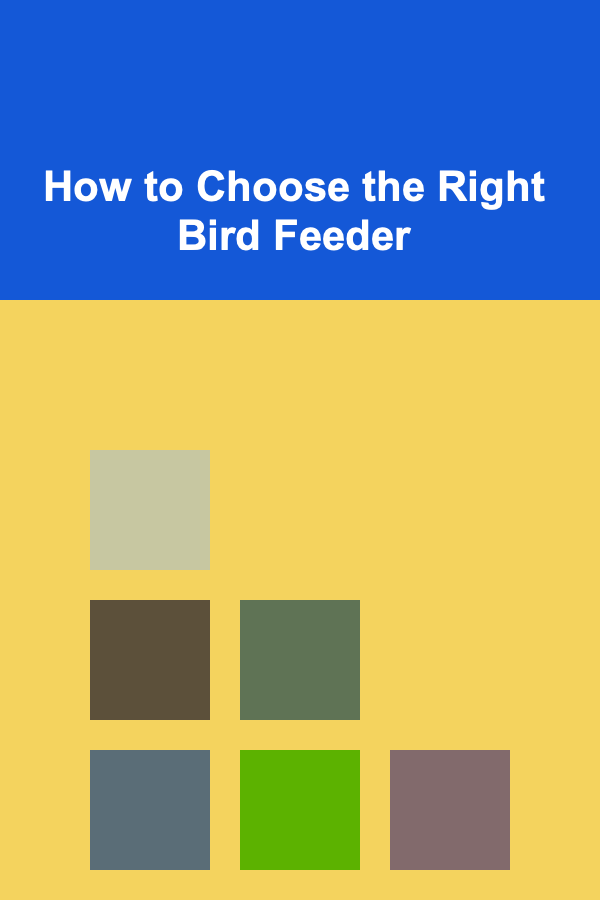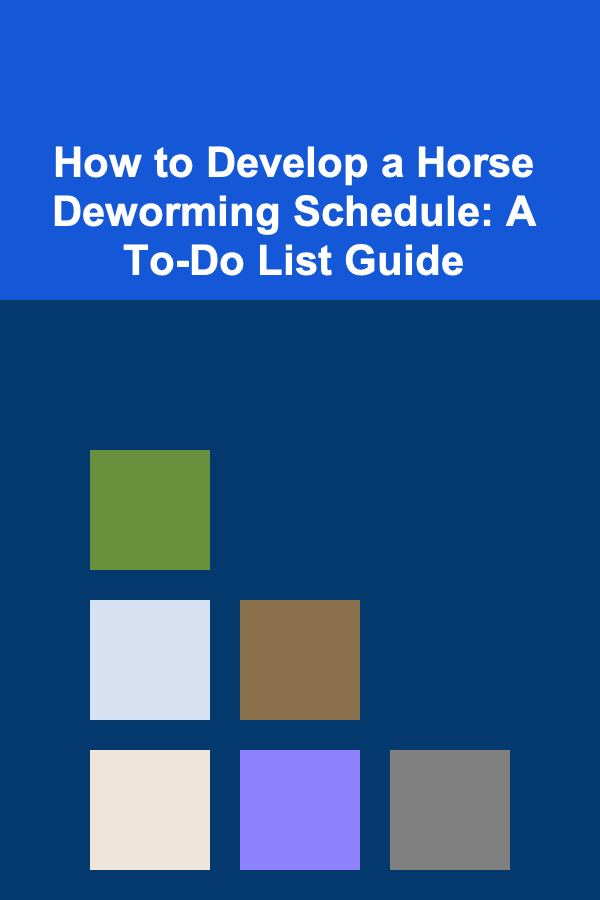
How to Choose the Right Bird Feeder
ebook include PDF & Audio bundle (Micro Guide)
$12.99$6.99
Limited Time Offer! Order within the next:

Choosing the right bird feeder can be an exciting yet overwhelming experience, especially for those new to birdwatching or anyone looking to attract more wildlife to their garden. With countless types, styles, and materials available, it can be difficult to know where to start. However, the right bird feeder can make a significant difference in attracting specific bird species to your garden and providing them with the food and shelter they need.
This article will guide you through the key factors to consider when selecting the ideal bird feeder, helping you make an informed decision for both the birds and yourself.
Understanding the Basics of Bird Feeding
Before diving into the specifics of bird feeder selection, it's important to understand why bird feeders are essential for birds and the different ways they support birdlife.
Bird feeders are designed to provide birds with a consistent food source. In urban and suburban environments, natural food sources such as seeds, berries, and insects can be scarce or unreliable. A well-placed feeder can provide a reliable source of nutrition, especially during harsh weather conditions or in areas where natural foraging is limited.
Bird feeders can also be an excellent way to observe local wildlife and contribute to the health and wellbeing of local bird populations. Different species of birds have different dietary needs, and the right feeder can attract a variety of birds to your backyard. In addition, by offering a variety of bird food options, you can encourage diversity and support different types of birds throughout the year.
Key Factors to Consider When Choosing a Bird Feeder
Selecting the right bird feeder for your backyard or garden involves evaluating several factors. The type of birds you want to attract, the space you have available, the feeder's durability, and ease of cleaning are just a few elements that should guide your decision.
1. Identify the Birds You Want to Attract
Understanding which birds are common in your area is crucial when choosing the right feeder. Different species of birds have different feeding habits, and catering to those preferences will help increase the likelihood of attracting them to your feeder.
- Seed-eating birds: Many backyard birds, such as sparrows, finches, and chickadees, are seed-eaters. They will visit feeders that offer a variety of seeds like sunflower seeds, thistle, and millet.
- Hummingbirds: If you're interested in attracting hummingbirds, you will need a specific type of feeder designed for liquid nectar. These feeders often have small ports that allow the tiny birds to feed comfortably.
- Woodpeckers: Woodpeckers have different feeding preferences. A suet feeder or a specialized feeder designed for their unique beaks is ideal for attracting woodpeckers.
- Squirrels: While not birds, squirrels are often attracted to bird feeders. If you're looking to keep them out, choose a squirrel-proof feeder that discourages their attempts to access birdseed.
Knowing the type of birds that are most common in your area will help you choose a feeder that suits their feeding behavior.
2. Feeder Types: Choosing the Right One for Your Space
Bird feeders come in a wide variety of designs. Each feeder type serves different purposes and caters to different bird species. Here are the most common types of feeders:
- Tube Feeders: These are the most versatile bird feeders and are suitable for attracting small to medium-sized seed-eating birds like finches, chickadees, and nuthatches. Tube feeders have multiple feeding ports and are ideal for use with black oil sunflower seeds or thistle. They tend to be squirrel-resistant due to their narrow design.
- Hopper Feeders: Also known as chalet feeders, these are typically larger and provide a continuous supply of birdseed. Hopper feeders can hold a significant amount of seed and are designed to attract a wide variety of birds, including cardinals, jays, and woodpeckers.
- Platform Feeders: As the name suggests, platform feeders are flat and open, providing a large surface for birds to land and feed. These feeders can accommodate a variety of seed types, suet, and even fruit, making them great for attracting different species of birds, including doves, jays, and sparrows.
- Suet Feeders: Suet feeders are specifically designed for woodpeckers and other insect-eating birds. Suet cakes are rich in fat and provide birds with high-energy food. Suet feeders often come in wire cages and are available in different shapes and sizes.
- Nectar Feeders: Nectar feeders are designed to attract hummingbirds. These feeders consist of small ports through which hummingbirds can sip nectar. It's essential to keep the nectar clean and replace it frequently to prevent spoilage.
- Nyjer Seed Feeders: These feeders are designed to hold thistle or nyjer seeds, which are loved by small finches, including goldfinches and purple finches. Nyjer feeders are typically tube-style and feature small openings through which the finches can access the seeds.
Each type of feeder is better suited for particular birds and environments. Consider the space you have available and the type of birds you wish to attract when making your choice.
3. Material Matters: Durability and Maintenance
When choosing a bird feeder, you'll want to consider the materials it's made from. The material will affect the feeder's durability, ease of cleaning, and ability to withstand the elements. Common materials include:
- Plastic: Plastic feeders are lightweight and come in various shapes and sizes. They are relatively inexpensive but may not last as long in harsh weather conditions. Over time, plastic can become brittle, especially if exposed to direct sunlight.
- Metal: Metal feeders are more durable and weather-resistant. They are often used for tube feeders, hopper feeders, and suet cages. However, metal feeders can sometimes heat up in the sun, which may affect the bird food, so be cautious in extremely hot weather.
- Wood: Wood is a natural material that blends well with outdoor environments, and it's often used for larger hopper feeders. However, wooden feeders may require more maintenance and are susceptible to damage from moisture, mold, or insects.
- Glass: Glass feeders are attractive and easy to clean. They often have a more decorative appearance and can be used for both seed and nectar. However, glass is breakable, so be cautious if you live in an area with heavy winds or where pets may be present.
- Concrete or Stone: Some high-end bird feeders are made from concrete or stone. These feeders are highly durable and can withstand a variety of weather conditions. However, they tend to be much heavier, which might make them less portable.
4. Squirrel-Proof Features
One of the challenges that many bird enthusiasts face is dealing with squirrels that raid the bird feeders. Squirrels are notorious for stealing birdseed and causing havoc in the garden. If you live in an area with a high squirrel population, you may want to invest in a squirrel-proof feeder. These feeders are designed to prevent squirrels from accessing the seed, often through mechanisms that close off access when a certain weight or pressure is detected (i.e., when a squirrel tries to feed).
Additionally, some feeders are designed with baffles or cages that prevent squirrels from reaching the food, while others may feature weight-activated perches that close off access to the seed when a heavier animal, like a squirrel, lands on them.
5. Ease of Cleaning and Refilling
Bird feeders need to be cleaned regularly to prevent mold, bacteria, and pests from contaminating the bird food. Moldy or spoiled food can harm the birds, so it's essential to choose a feeder that is easy to clean and refill. Many feeders feature removable trays, openings, or bottoms that make cleaning more accessible.
Hopper and tube feeders typically have removable tops or bottom trays that allow for easy refilling and cleaning. Suet feeders often feature a simple wire design that is easy to wipe down.
Ensure that the feeder is accessible and that you can clean it without difficulty. A well-maintained feeder will encourage healthy birds and help you enjoy the birdwatching experience more.
6. Placement of the Bird Feeder
The location of your bird feeder plays a crucial role in attracting birds. Be sure to place your feeder in a location that is safe for the birds and allows you to enjoy the view. Consider the following when placing your feeder:
- Safety: Place the feeder away from predators, such as cats or hawks. It's best to position the feeder near trees, shrubs, or other structures where birds can take cover from predators.
- Visibility: Choose a spot that provides a clear view of the surrounding area. This allows birds to quickly spot potential threats and provides a peaceful environment for feeding.
- Shelter from the Elements: Protect the feeder from strong winds, heavy rain, or direct sunlight. A sheltered area will help protect the bird food from the elements and keep it fresh longer.
7. Budget and Quality
Bird feeders come in a wide range of prices, from inexpensive plastic feeders to more expensive, handcrafted metal or stone options. While it may be tempting to go for the cheapest option, remember that a high-quality feeder will last longer, attract more birds, and be easier to maintain.
Investing in a durable, well-made feeder will ensure that it performs well over time and provides a reliable food source for birds.
Conclusion
Choosing the right bird feeder is about more than just aesthetics; it's about providing a safe and reliable food source for the birds while also enhancing your outdoor space. By understanding the birds you want to attract, the types of feeders available, and the materials and features that best suit your needs, you can make a thoughtful choice that benefits both you and the local birdlife.
With the right feeder in place, you'll soon enjoy watching a variety of beautiful birds flock to your yard, bringing life and color to your outdoor space. Whether you're an experienced birdwatcher or just getting started, the right feeder can enhance your birding experience and contribute to the wellbeing of your local bird population.
Reading More From Our Other Websites
- [Organization Tip 101] How to Maintain and Care for Your Farmhouse Kitchen Sink
- [Home Soundproofing 101] How to Soundproof a Baby's Room for a Quiet Nursery
- [Reading Habit Tip 101] Reading Fiction for Mental Health: Tips to Make It a Healing Habit
- [Organization Tip 101] How to Use Cash Flow Projections for Better Planning
- [Home Security 101] How to Secure Sliding Glass Doors Against Break-ins
- [Home Maintenance 101] How to Create a Personalized Seasonal Home Maintenance Guide for Every Climate and Property Type
- [Home Soundproofing 101] How to Choose and Install Acoustic Wall Panels for Home Soundproofing
- [Biking 101] Top 10 Features to Look for in a City Bike
- [Needle Felting Tip 101] From Sketch to Felt: Designing and Executing a Needle‑Felted Urban Skyline
- [Home Cleaning 101] How to Clean and Organize Your Pantry for Better Storage

How to Choose the Right Renovation for Your Home's Layout
Read More
How to Make Money Online as a Construction Surveyor: 10 Actionable Ideas
Read More
How to Make Money Online as a Mechanical Engineer: 10 Actionable Ideas
Read More
Smart Shopping: Tips for Buying Used Electronics Without the Risk
Read More
Metal Detecting for Native American Artifacts: 10 Safety Tips
Read More
How to Develop a Horse Deworming Schedule: A To-Do List Guide
Read MoreOther Products

How to Choose the Right Renovation for Your Home's Layout
Read More
How to Make Money Online as a Construction Surveyor: 10 Actionable Ideas
Read More
How to Make Money Online as a Mechanical Engineer: 10 Actionable Ideas
Read More
Smart Shopping: Tips for Buying Used Electronics Without the Risk
Read More
Metal Detecting for Native American Artifacts: 10 Safety Tips
Read More